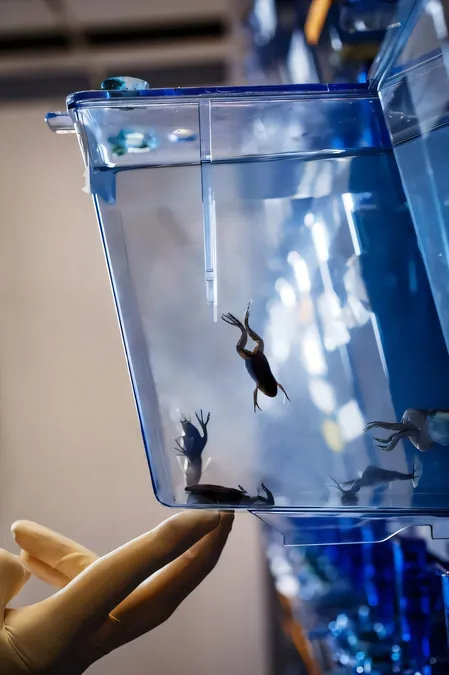
Breakthrough Study: Harmless Viruses Unveiling the Mysteries of Frog Nervous Systems!
2024-11-26
Author: Benjamin
Breakthrough Study: Harmless Viruses Unveiling the Mysteries of Frog Nervous Systems!
When you hear the term "virus," it often invokes fear and images of illness. However, not all viruses are harmful; some are being harnessed for therapeutic purposes and groundbreaking research. A recent study published in *Developmental Cell* underscores this innovative application, demonstrating how harmless viruses can illuminate the nervous system of frogs—a discovery set to revolutionize amphibian neurobiology.
This remarkable study was led by an international consortium known as EDGE, helmed by the Sweeney Lab at the Institute of Science and Technology Austria (ISTA) and the Tosches Lab at Columbia University. Their research unveils a novel method using adeno-associated viruses (AAVs) to track the intricate metamorphosis of frogs from their early tadpole stages into adult forms. This breakthrough offers deep insights into the amphibian nervous system during a critical developmental phase.
The Fascinating Metamorphosis of Frogs
David Vijatovic and Lora Sweeney present a mesmerizing scene in a lab filled with aquatic tanks housing African clawed frogs (*Xenopus laevis*). As they observe, the tadpoles swim effortlessly, eventually transitioning into these agile creatures capable of walking on land. "Frogs undergo metamorphosis, making them an exceptional model for studying transitions between swimming and walking," Sweeney explains. The transformation, spanning approximately 12 to 16 weeks, provides ample opportunity for scientists to study each developmental stage intricately.
As the frogs progress from embryo to tadpole, through various forms, to their adult state, researchers can delve into locomotive behaviors and uncover the underlying changes in their nervous systems.
Understanding the Wiring of Frog Nervous Systems
The nervous system functions as an intricate circuit, with neurons communicating much like an electrical network. "The way we behave and interact with the world stems from how neurons are connected and transmit information," states Sweeney. But understanding the specifics of this wiring is vital. How are neurons interconnected? What messages do they convey to one another?
To address this, the research team cleverly uses AAVs—viruses that can infect a wide range of cell types without causing disease. These AAVs can be engineered to emit a striking green fluorescence under a microscope, enabling scientists to visually trace nerve cell connections and neural circuit dynamics.
Historically, the application of AAVs has been restricted primarily to well-studied organisms like mice. "The widespread belief was that this method couldn't be applied to amphibians—until now," declares Vijatovic.
Collaboration: The Key to Success
This groundbreaking technique was made possible through collaborative efforts among an international team of experts—comprised of scientists from Columbia University, Tel Aviv University, the University of Utah, Scripps Research Institute, and Caltech. The collective insights from this diverse group fostered innovative ideas and approaches, critical for overcoming challenges in researching lesser-known species.
The team meticulously screened existing AAVs to optimize their infectivity in amphibians, eventually producing a comprehensive guide for AAV application in frogs and newts. "Our journey took us from young tadpoles through various stages up to adult frogs, tailoring our methods for each life phase," Vijatovic shared.
Broader Implications: Insights into Evolution and Human Biology
This pioneering method is not just a triumph for amphibian research; it also opens avenues for comparative studies between the nervous systems of frogs and mammals, including humans. Despite diverging from a common ancestor approximately 360 million years ago, frogs and mammals share fundamental traits. Such comparative studies can illuminate the evolutionary path of our own nervous systems.
By understanding the building blocks of amphibian nervous systems, researchers hope to glean insights into how human neural structures evolved and specialized over time. "The deeper our comprehension of these basic elements, the better equipped we are to address issues related to disease and injury," concludes Sweeney.
In summary, this groundbreaking study not only marks a significant advancement in the field of neurobiology but also enhances our understanding of brain development across species—a fascinating journey into the depths of life itself! Stay tuned for more updates as science continues to unveil the mysteries of our biological world!









 Brasil (PT)
Brasil (PT)
 Canada (EN)
Canada (EN)
 Chile (ES)
Chile (ES)
 España (ES)
España (ES)
 France (FR)
France (FR)
 Hong Kong (EN)
Hong Kong (EN)
 Italia (IT)
Italia (IT)
 日本 (JA)
日本 (JA)
 Magyarország (HU)
Magyarország (HU)
 Norge (NO)
Norge (NO)
 Polska (PL)
Polska (PL)
 Schweiz (DE)
Schweiz (DE)
 Singapore (EN)
Singapore (EN)
 Sverige (SV)
Sverige (SV)
 Suomi (FI)
Suomi (FI)
 Türkiye (TR)
Türkiye (TR)